Podcast
Questions and Answers
Gastrulation begins with the formation of the primitive streak on the surface of the hypoblast.
Gastrulation begins with the formation of the primitive streak on the surface of the hypoblast.
False (B)
The primitive streak is clearly visible as a narrow groove in a 15- to 16-day embryo.
The primitive streak is clearly visible as a narrow groove in a 15- to 16-day embryo.
True (A)
Cell migration and specification during gastrulation are controlled by fibroblast growth factor 8.
Cell migration and specification during gastrulation are controlled by fibroblast growth factor 8.
True (A)
The cephalic end of the primitive streak is known as the primitive node.
The cephalic end of the primitive streak is known as the primitive node.
FGF8 controls cell movement by upregulating E-cadherin, a protein that normally binds epiblast cells together.
FGF8 controls cell movement by upregulating E-cadherin, a protein that normally binds epiblast cells together.
Flashcards
Does gastrulation begin with the formation of the primitive streak?
Does gastrulation begin with the formation of the primitive streak?
The primitive streak, a thickening along the epiblast, marks the beginning of gastrulation, not its end. Gastrulation is a complex process that involves the formation of germ layers and the establishment of the body axes. The primitive streak formation signifies the start of this crucial developmental event.
When is the primitive streak visible in an embryo?
When is the primitive streak visible in an embryo?
The primitive streak, visible as a narrow groove on the epiblast, can be observed in a 15- to 16-day embryo. This streak is a key feature of early embryonic development and provides the foundation for the formation of the three germ layers (ectoderm, mesoderm, and endoderm). As gastrulation progresses, the primitive streak elongates and shrinks, eventually disappearing.
What is the role of FGF8 in gastrulation?
What is the role of FGF8 in gastrulation?
Fibroblast growth factor 8 (FGF8) plays a crucial role in gastrulation by regulating cell migration and specification. It acts as a signaling molecule that directs cells to their appropriate locations during embryonic development. The specific mechanism involves the downregulation of cell adhesion proteins, allowing cells to detach and migrate.
What is the cephalic end of the primitive streak called?
What is the cephalic end of the primitive streak called?
Signup and view all the flashcards
How does FGF8 control cell movement?
How does FGF8 control cell movement?
Signup and view all the flashcards




